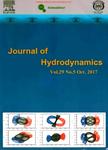A NUMERICAL STUDY ON MECHANISM OF S-STARTS OF NORTHERN PIKE (ESOX LUCIUS)
A NUMERICAL STUDY ON MECHANISM OF S-STARTS OF NORTHERN PIKE (ESOX LUCIUS)作者机构:Department of Engineering Mechanics Shanghai Jiaotong University Shanghai 200240 China Laboratory for Biomechanics of Animal Locomotion Graduate University of the Chinese Academy of Sciences Beijing 100039 China Laboratory for Biomechanics of Animal Locomotion Graduate University of the Chinese Academy otSciences Beijing 100039 China Department of Electronics and Mechanical Engineering Chiba University Japan
出 版 物:《Journal of Hydrodynamics》 (水动力学研究与进展B辑(英文版))
年 卷 期:2007年第19卷第2期
页 面:135-142页
核心收录:
学科分类:0710[理学-生物学] 07[理学] 08[工学] 09[农学] 0901[农学-作物学] 0836[工学-生物工程] 090102[农学-作物遗传育种] 071002[理学-动物学]
基 金:Project supported by the National Natural Science Foundation of China (Grant Nos.10332040, 10502033) the Innovation Project of the Chinese Academy of Sciences (Grant No. KJCX-SW-L04)
主 题:S-starts of fish swimming Navier-Stokesequations mechanism of force production
摘 要:Northern pike is regarded as a specialist in swimming acceleration. The force production mechanism of northern pike, Esox lucius, during its predation S-starts was numerically studied in this article. The problem was reasonably simplified to a loose-coupling problem of fish swimming dynamics and hydrodynamics just in the swimming direction. The approach involved the simulation of the flow by solving the two-dimensional unsteady incompressible Navier-Stokes equations and decribing the fish motion dynamics based on Newton's Second Law. Visualizations of flow fields and vortex structures were performed. The results show that the large acceleration is obtained mainly in the first undulatory cycle in which the amplitude increases. In the second cycle, a couple of vortices are generated and induce a jet. In the third cycle, the jet is strengthened by the mergence of the vortices in the same direction. Through discussing the effects of various controllable factors on the swimming performance, it is found that the actual locomotion mode of the northern pike in nature is just the best choice.



